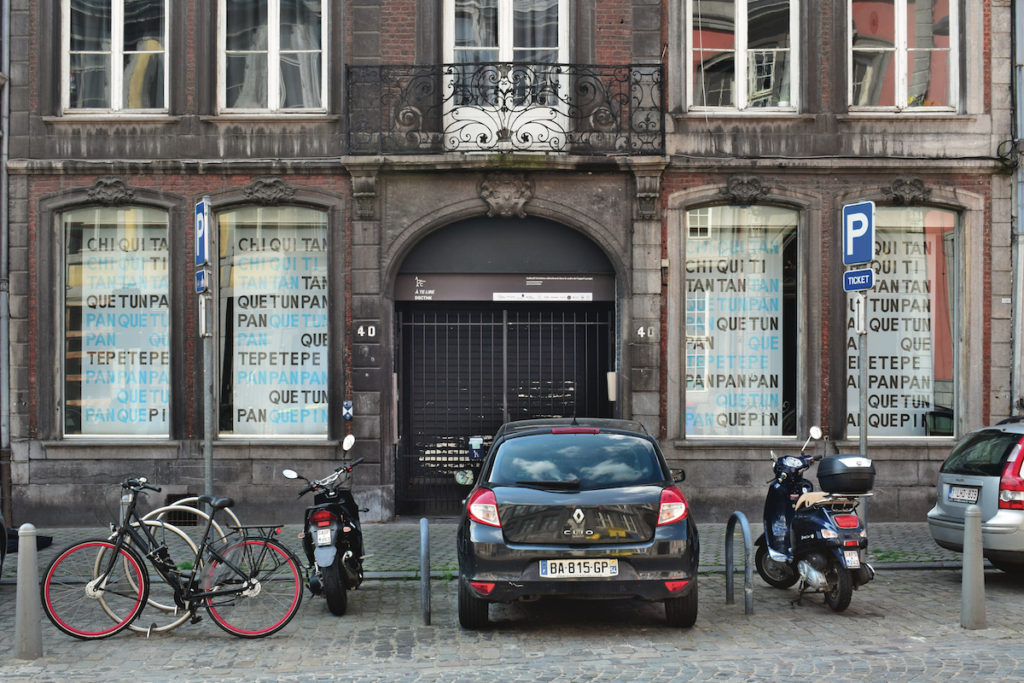-
Histoires simples
Léopold Mottet 1 students
107 Féronstrée
-
Qu’est-ce-qui se trame ici ?
Centre André Baillon
1 Féronstrée
-
Night Walk
Maria Chiara Ziosi
85 Rue de la Cathédrale
-
Thy Cities Shall With Commerce Shine — Part II
Hattie Wade
35 Rue Souverain Pont
-
La Maison Panure – Fève des rois
JJ von Panure
21 Pont d'Île
-
MANTERO
Santiago Vélez
4 Rue de la Cathédrale
-
Mobile Écriture Automatique
Philippe José Tonnard
109 rue de la Cathédrale
-
ST END
Pablo Perez
10 Rue Nagelmackers
-
ALREADYMADE n° 3 : Empty Cart or Cardboard Cybertruck
M.Eugène Pereira Tamayo
18 Rue de l'Etuve
-
Centre de remise en forme (économie de guerre)
Werner Moron
7 Rue de l'Official (Îlot Saint-Michel)
-
Sun(set)(Seed)
Matthieu Michaut
56 Rue Saint-Gilles
-
precarity of non-human entities
Gérard Meurant
23 Rue Saint-Michel
-
S’aligne, l’inconnue sans lecture
Julia Kremer
40 Rue Hors-Château
-
Autumn Collages
Ívar Glói Gunnarsson Breiðfjörð
30 Rue de la Cathédrale
-
Rōt Rot Rôt
Janina Fritz
28 Rue des Carmes
-
Pierre ventilée
Daniel Dutrieux
14 Rue de la Populaire (Îlot Saint-Michel)
-
Peephole
Jacques Di Piazza
31a Rue de la Cathédrale
-
Room Eater
Jorge de la Cruz
5 Rue Saint-Michel (Îlot Saint-Michel)
-
Behind the Curtain
Francesca Comune
31b Rue de la Cathédrale
-
COMMENT
Kim Bradford
16 Rue du Palais
-
Pedro Camejo (série Diaspora)
Omar Victor Diop
25 Rue Saint Paul
-
L’impasse de la vignette, dans le temps et dans l’espace
Michel Bart and Mathias Vancoppenolle
75 Rue Hors-Château
-
Opéra-savon, épisode 1 : L’ Aquarium-Museum
Clara Agnus
20 Rue de la Sirène
Warning: Undefined array key "current_expo" in /var/www/clients/client3/web4/web/wp-content/themes/artaucentre/loop/vitrine.php on line 25

À TE LIRE
#6
DSCTHK Jérôme André and Thibaut Blondiau
Open call
130Hôtel de la Cour de Londres 40 Rue Hors-Château
Emerging from a flood of lasers and smoke bombs, the mechanical and technoid man, decked out in mikes and lights, strikes up 1991 music hit asi me gusta mi, starting with several battle shouts, before carrying on with a phonetic litany, whose sense, 30 years later, still remains a mystery for the algorithms of online translators. After a trial period in the clubs of the Ruta Del Bakalao in the Valencia region, the hit by robot artist and Spanish DJ Chimo Bayo spreads like wild fire through the dance floors of the continent, where, for those willing to hear it, an incantation destined for synthetic psychoactive drugs resonates.
For Art au Centre, DSCTHK isolated the phonetic components of the opening litany of the song, as if they were trying to find the formula. The structure of the extract is made of a dozen of sound particles that the artists transferred into a table, like in a periodic table of the elements. The identified phonemes articulate in different ways to form the melodic and rhythmic writing part of the song. The resulting division reduces it to a sort of metric system, to the sequentiality of electronic music or to the automation of the reading of punch cards that conduct mechanical orchestras.
This « mechanization » of Chimo Bayo’s hit, which has not been left behind, can’t overshadow the poetic value that the artists try to give to the extract in view of its simple statement value. They see a form of abstract poetry, made of onomatopoeias, a Dadaist experience in today’s city, a free speech as envisioned by futuristic poets. The observer is thus invited to engage in a reading that stretches from one window to another, step by step, for a progressively mastered statement. The feats will produce scat duels in the street ; a simple vocal game of syllables and rhythmic onomatopoeias, specific to jazz music this time, whose sense is only its own musicality.

